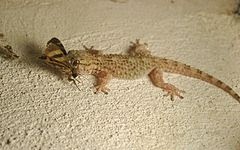| P.tiliguerta male |
There are of course many species of reptiles on Corsica, but
as this was a mainly bird and botany focussed holiday we did not go seeking
them out especially. Despite this, we found at least three species of lizard,
including the endemic Tyrrhenian Wall Lizard Podarcis tiliguerta. This was the
most widely seen of all the lizards we found, occurring from sea level up to
altitude, and they were obvious whenever the sun was out and they could bask.
| P.tiliguerta |
| P.sicula |
The various species of Podarcis are widely distributed
around the Mediterranean and North Africa, with one species reaching Madeira in
the Atlantic, and they have a tendency to colonise even small islets where they
form endemic subspecies. They have also been introduced outside their range,
with two species introduced to parts of North America and even a small colony
as far north as the south of England. This has been going on for some time, as
Corsica is also home to the more widespread Italian Wall Lizard P.sicula, which was probably introduced by the Romans. It is unusual
for two species of Podarcis to be found sharing an island, and on Corsica P.tiliguerta
seems to be more adapted to the mountains that make up most of the island, while
P.sicula we found in sand dunes along the coast, although what the precise ecological
requirements are is not clear. Wall lizards are generalist insectivores,
feeding on a variety of crickets, beetles, and the like.
 |
| T.mauretanica |
The other lizard we found was a couple of specimens of the
very widespread Moorish Gecko, Tarentola mauretanica. This is one of the two
commonly seen geckos around the Mediterranean (the other is the Turkish Gecko
Hemidactylus turcicus), and is the largest European gecko. Although like most
geckos they are nocturnal, they do bask in the late afternoon sun and that is
how we found them, although I did not manage to get a decent photo. They
concentrate on nocturnal insects such as moths, and around houses they are
often seen under street lights.
Next time, mammals
(Moorish gecko photo from Wikipedia, rest are mine)
No comments:
Post a Comment